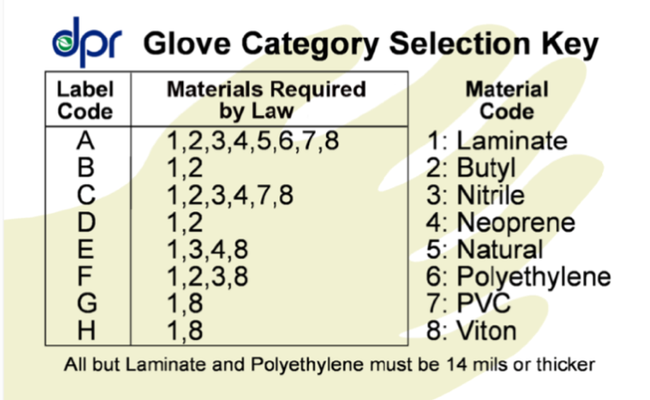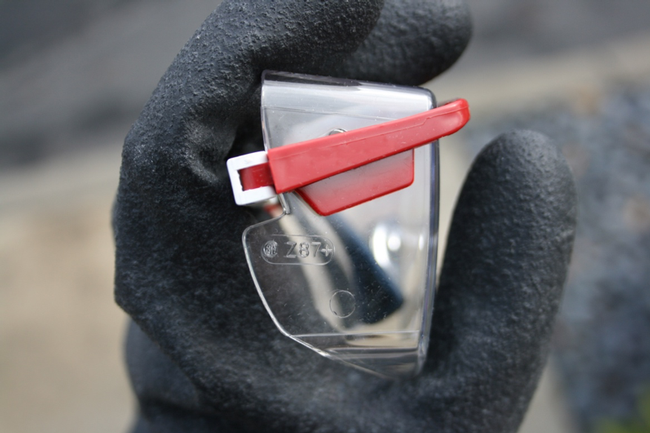Public concern regarding the risk of illness from long-term exposure to glyphosate is on the rise. In order to reduce exposure to this common herbicide, or any other pesticide, it's important that applicators wear the right personal protective equipment (PPE), not only for personal safety, but also to comply with California regulations.
Signal words and glyphosate
Pesticide labels contain a signal word, which describes the effects of acute or immediate toxicity from unprotected exposure to the chemical. Signal words are CAUTION, WARNING, DANGER, and DANGER-POISON (see the Spring 2019 issue of the retail newsletter for more http://ipm.ucanr.edu/PDF/PUBS/Spring_2019_Retail_Newsletter.pdf).
Most commercial glyphosate products have the signal word “CAUTION,” which indicates the chemical can cause moderate eye irritation, is harmful if inhaled, and to avoid contact with eyes and clothing and breathing in the vapor from spray mist.
Some glyphosate products may have the signal word “WARNING” on the label and advise against contact with eyes or clothing because the product can cause substantial but temporary eye injury including other adverse reactions.
While pesticide labels do not warn against specific chronic health issues associated with their use, PPE, safe handling procedures, and pesticide label instructions reduce long-term or chronic pesticide handler health risks. According to the Agricultural Health Study, chemical-resistant gloves can reduce pesticide exposure between 50 to 80 percent. For more information specific to glyphosate, see this blog post.
What are the California regulations?
California pesticide safety regulation for PPE is often stricter than the requirements of the federal pesticide label, mandating at a minimum that protective eyewear and chemical-resistant gloves are worn by licensed applicators, even if they are not mentioned on the federal pesticide label and regardless of the product signal word.
These state requirements for protective eyewear and chemical-resistant gloves for handlers are detailed in the California Code of Regulation Section 6738.1 and were adopted by the state more than three decades ago.
In the most recent pesticide injury illness report from 2015, there are 8 cases of handler pesticide illness due to glyphosate. Two of these cases were eye injuries from failure to wear the appropriate PPE in applying glyphosate by itself or in combination with other products, according to a California Pesticide Illness Surveillance Program review.
According to a 2013 review of the previous decade from the California Department of Pesticide Regulation (CDPR), on average, 1 in 3 reports of pesticide illness involving poisoning or skin injury is due to handler failure to wear the appropriate PPE.
It is clear that selecting the appropriate PPE and wearing it correctly reduces the risk of pesticide-related illness. If you do not have access to the right PPE, notify your employer of any equipment issue that interferes with following the requirements on the label and the minimum state requirements for PPE.
PPE for glyphosate handlers

For anyglyphosate products that have a “WARNING” label, coveralls are required in California, even if it is not required by the label. This rule applies to all products labeled as “WARNING” or “DANGER” in California, not just those containing glyphosate.
When using backpack sprayers that are known to leak during an application, consider wearing coveralls for glyphosate products rated “CAUTION.”
Eyewear: Handlers must wear the type of eyewear that is specified by the pesticide product labeling. If the label does not specify that eyewear is required, handlers can choose to wear either a face shield, goggles, or safety glasses that provide front, side, and brow protection.
All types of protective eyewear must be labeled “Z87.1” or “Z87+” to indicate that it meets the 2010 American National Standards Institute standard for impact resistance. This is done using permanent, raised lettering (Figure 1) and indicates that the manufacturer certifies that its eyewear meets the defined baseline of protection.
Gloves: If the label does not specify that gloves are required, or if it only states that chemical-resistant or waterproof gloves are required, handlers can choose to wear gloves of any chemical-resistant material, provided they are the appropriate thickness of 14 mils or greater.The California Department of Pesticide Regulation developed a wallet-sized Glove Category Selection Key (Figure 2) to help label readers identify the correct glove material for their situation.
The PPE listed under the precautionary statements of the pesticide label provide a barrier between your body and the pesticide. Remember to read and follow equipment requirements on all labels including complying with the minimum PPE requirements in California to protect yourself from the unwanted effects of acute and chronic exposure.
[Original article published in the Fall 2019 issue of the Green Bulletin.]
Author - Coordinator, Pesticide Safety Education Program and Office of Pesticide Information and Coordination (OPIC)
